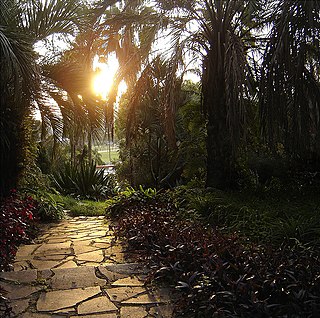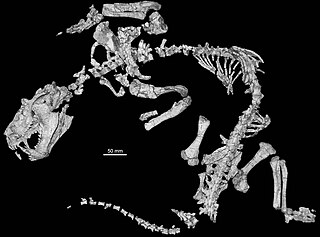
The Federal University of Rio Grande do Sul is a Brazilian public federal research university based in Porto Alegre, Rio Grande do Sul. UFRGS is among the largest and highest-rated universities in Brazil, having one of the largest number of scientific publications. From 2012 to 2019, the university was elected as the best federal university of Brazil. UFRGS has over 31,000 undergraduate students, over 12,000 graduate students, and more than 2,600 faculty members. As a Brazilian public federal institution, students do not pay tuition fees to enroll in courses offered by the university.

Friedrich von Huene born Friedrich Richard Freiherr von Hoyningen-Huene was a German nobleman paleontologist who described a large number of dinosaurs, more than anyone else in 20th century Europe. He studied a range of Permo-Carboniferous tetrapods. He worked at the collections of the institute and museum for geology and paleontology at the University of Tübingen.

The Federal University of Santa Maria is a Brazilian public university located in Santa Maria, in the state of Rio Grande do Sul, funded by the federal government of Brazil. It was founded in 1960, by Professor José Mariano da Rocha Filho. Its campuses span over 1,837.72 ha, with a total of 386,968 m2 of buildings and 28,307 students.

Unisinos is a Brazilian private Jesuit university founded in 1969. Its main campus is located in Southern Brazil, in the city of São Leopoldo, state of Rio Grande do Sul. Unisinos has more than 30,000 students in its 91 undergraduate programs, 19 academic master's programs, 6 professional master's programs, and 14 PhD programs, with six schools – Polytechnic, Business, Law, Health, Creative Industry, and Humanities.
The Jackson School of Geosciences at The University of Texas at Austin unites the Department of Earth and Planetary Sciences with two research units, the Institute for Geophysics and the Bureau of Economic Geology.

The Sanga da Alemoa paleontological site is located in the city of Santa Maria, Rio Grande do Sul, in Brazil. It belongs to the Caturrita Formation and the Santa Maria Formation. It is located in the neighborhood of Castelinho. The site belongs to the paleorrota region.

The PUCRS Museum of Science and Technology is a Brazilian museum run by the Pontifical Catholic University of Rio Grande do Sul (PUCRS), located in the city of Porto Alegre in Rio Grande do Sul, at Ipiranga Av. 6681, Building 40, Parthenon. Visiting hours are from 9 am to 5 pm Tuesday to Friday and 10 am to 6 pm during the weekend.

The Porto Alegre Botanical Garden is a Foundation of Rio Grande do Sul located on the street Salvador França, in Porto Alegre, Brazil.

The Museum Vicente Pallotti is located on Avenida Presidente Vargas, 115 in Santa Maria, Rio Grande do Sul, Brazil. It is located in the same complex Palotina College (FAPAS). Visits need to be scheduled in advance.

The Higher School of Advertising and Marketing is a private higher education institution in Brazil.

The Aristides Carlos Rodrigues Museum is located at Avenue Pereira Rego, 1000, in the town of Candelária, in the state of Rio Grande do Sul, Brazil. It is a museum of Geopark of Paleorrota with information on the region. It was inaugurated in July 2001.

Daniel Cargnin (1930–2002) was a Brazilian priest and amateur paleontologist born in Nova Palma, in the state of Rio Grande do Sul, Brazil, in 1930. He died in 2002, and at his request was buried in the town of Mata.

Trucidocynodon is an extinct genus of ecteniniid cynodonts from the Upper Triassic (Carnian) of Brazil. It contains a single species, Trucidocynodon riograndensis. Fossils of Trucidocynodon were discovered in outcrops of the Upper Santa Maria Formation in Paleorrota Geopark, Agudo. Trucidocynodon is one of the most completely known Triassic cynodonts, as its holotype is a nearly complete and fully articulated skeleton.

Cidade Baixa is a neighborhood of the city of Porto Alegre, the state capital of Rio Grande do Sul in Brazil. The neighborhood was created by the law number 2022 of December 7, 1959.
Atílio Munari was a Brazilian paleontologist.
Vicentino Prestes de Almeida was a Brazilian paleontologist.
Irajá Damiani Pinto, was a Brazilian paleontologist and professor at the Federal University of Rio Grande do Sul, a member of the Brazilian Academy of Sciences, and a two time president of the Brazilian Geological Society.
Romeu Beltrão (1913–1977), was a Brazilian physician, educator, historian and paleontologist. He was born and died in Santa Maria, Rio Grande do Sul, Brazil.

The Museu de Ciências Naturais da Fundação Zoobotânica do Rio Grande do Sul, is a Brazilian museum located inside the Porto Alegre Botanical Garden. Open from Monday to Sunday 9am to 12pm and from 13h30 to 17h.

The Universidade Regional do Cariri (URCA) is a Brazilian state public university with its administrative headquarters in the city of Crato, with other campuses in the city of Juazeiro do Norte and decentralized units in Iguatu, Campos Sales and Missão Velha. Additionally, it encompasses the Plácido Cidade Nuvens Paleontology Museum in Santana do Cariri. URCA serves an academic community of approximately 12,500 students from around 111 municipalities in the states of Ceará, Piauí, Pernambuco and Paraíba, distributed between undergraduate education, special programs and lato sensu postgraduate education.















